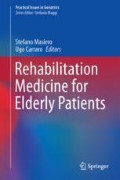Abstract
Malnutrition or the risk of being malnourished is high among orthogeriatric patients. A poor nutritional status is associated with negative health outcomes. Comprehnesive pre- and postoperative management of nutritional and fluid intake improves rehabilitative results in orthogeriatrics patients.
Access this chapter
Tax calculation will be finalised at checkout
Purchases are for personal use only
References
Nuotio M, Tuominen P, Luukkaala T (2016) Association of nutritional status as measured by the Mini-Nutritional Assessment Short Form with changes in mobility, institutionalization and death after hip fracture. Eur J Clin Nutr 70:393–398
Goisser S, Schrader E, Singler K et al (2015) Malnutrition according to Mini Nutritional Assessment (MNA) is associated with severe functional impairment in geriatric patients before and up to 6 months after hip fracture. J Am Med Dir Assoc 16:661–667
Drevet S, Bioteau C, Mazière S et al (2014) Prevalence of protein-energy malnutrition in hospital patients over 75 years of age admitted for hip fracture. Orthop Traumatol Surg Res 100:669–674
Kaiser MJ et al; MNA-International Group (2009) Validation of the Mini Nutritional Assessment short-form (MNA-SF): a practical tool for identification of nutritional status. J Nutr Health Aging 13:782–788
Hooper L et al (2014) Water-loss dehydration and aging. Mech Ageing Dev 136–137:50–58
Koren-Hakim T et al (2012) The relationship between nutritional status of hip fracture operated elderly patients and their functioning, comorbidity and outcome. Clin Nutr 31:917–921
Rosenberg IH (1997) Sarcopenia: origins and clinical relevance. J Nutr 127(5 Suppl):990S–991S
Baumgartner R, Koehler KM, Gallagher D, Romero L, Heymsfield SB, Ross RR, Garry PJ, Lindeman RD (1998) Epidemiology of sarcopenia among the elderly in New Mexico. Am J Epidemiol 147:755–763
Janssen I, Heymsfield SB, Robert R (2002) Low relative skeletal muscle mass (sarcopenia) in older persons is associated with functional impairment and physical disability. J Am Geriatr Soc 50:889–896
Cruz-Jentoft A, Baeyens JP, Bauer J et al (2010) Sarcopenia: European consensus on definition and diagnosis. Age Ageing 39:412–423
Muscaritoli M, Anker SD, Argiles J et al (2010) Consensus definition of sarcopenia, cachexia and pre-cachexia: joint document elaborated by Special Interest Groups (SIG) “cachexia-anorexia in chronic wasting diseases” and “nutrition in geriatrics”. Clin Nutr 29:154–159
Zamboni M, Mazzali G, Fantin F et al (2008) Sarcopenic obesity: a new category of obesity in the elderly. Nutr Metab Cardiovasc Dis 18:388–395
Goisser S, Kemmler W, Porzel S et al (2015) Sarcopenic obesity and complex interventions with nutrition and exercise in community-dwelling older persons – a narrative review. Clin Interv Aging 10:1267–1282
Drey M, Sieber CC, Bertsch T et al (2016) Osteosarcopenia is more than sarcopenia and osteoporosis alone. Aging Clin Exp Res 28:895–899
Fried LP, Tangen CM, Walston J et al; Cardiovascular Health Study Collaborative Research Group (2001) J Gerontol A Biol Sci Med Sci 56:M146–M156
Rockwood K, Mogilner A, Mitnitski A (2004) Changes with age in the distribution of a frailty index. Mech Ageing Dev 125:517–519
Bartali B, Frongillo EA, Bandinelli S et al (2006) Low nutrient intake is an essential component of frailty in older persons. J Gerontol Med Sci 61A:589–593
Drey M, Wehr H, Wehr G et al (2011) The frailty syndrome in general practitioner care: a pilot study. Z Gerontol Ger 44:48–54
Rockwood K, Andrew M, Mitnitski A (2007) A comparison of two approaches to measuring frailty in elderly people. J Gerontol A Biol Sci Med Sci 62(7):738–743
Evans WJ, Morley JE, Argiles J et al (2008) Cachexia: a new definition. Clin Nutr 27:793–799
Bauer J, Biolo G, Cederholm T et al (2013) Evidence-based recommendations for optimal dietary protein intake in older people: a position paper from the PROT-AGE Study Group. J Am Med Dir Assoc 14:542–549
Goisser S, Schrader E, Singler K et al (2015) Low postoperative intake is associated with worse functional course in geriatric patients up to 6 months after hip fracture. Br J Nutr 113:1940–1950
Paddon-Jones D, Rasmussen HH (2009) Dietary protein recommendations and the prevention of sarcopenia. Curr Opin Clin Nutr Metab 12:86–90
Milne AC, Potter J, Vivanti A et al (2009) Protein and energy supplementation in elderly people at risk from malnutrition. Cochrane Database Syst Rev 2:CD003288
Bauer JM, Verlaan S, Bautmans I et al (2015) Effects of a vitamin D and leucine-enriched whey protein nutritional supplement on measures of sarcopenia in older adults, the PROVIDE study: a randomized, double-blind, placebo-controlled trial. J Am Med Dir Assoc 16:740–747
Kondrup J, Rasmussen HH, Hamberg O et al (2003) Nutritional risk screening (NRS 2002): a new method based on an analysis of controlled clinical trials. Clin Nutr 22:321–336
Cederholm T, Barazzoni R, Austin P et al (2016) ESPEN guidelines on definitions and terminology in clinical nutrition. Clin Nutr 36(1):49–64. pii: S0251-5614(16)31242-0
Volkert D et al (2013) Leitlinie der Deutschen Gesellschaft für Ernährungsmedizin (DGEM) in Zusammenarbeit mit der GESKES, der AKE und der DG: Klinische Ernährung in der Geriatrie. Aktuell Ernährungsmedizin 38:e1–e48
Huxtable S, Palmer M (2013) The efficacy of protected mealtimes in reducing mealtime interruptions and improving mealtime assistance in adult inpatients in an Australian hospital. Eur J Clin Nutr 67:904–910
Author information
Authors and Affiliations
Corresponding author
Editor information
Editors and Affiliations
Rights and permissions
Copyright information
© 2018 Springer International Publishing AG
About this chapter
Cite this chapter
Sieber, C.C. (2018). The Role of Nutrition in Rehabilitation of Older Adults. In: Masiero, S., Carraro, U. (eds) Rehabilitation Medicine for Elderly Patients. Practical Issues in Geriatrics. Springer, Cham. https://doi.org/10.1007/978-3-319-57406-6_21
Download citation
DOI: https://doi.org/10.1007/978-3-319-57406-6_21
Published:
Publisher Name: Springer, Cham
Print ISBN: 978-3-319-57405-9
Online ISBN: 978-3-319-57406-6
eBook Packages: MedicineMedicine (R0)

